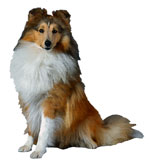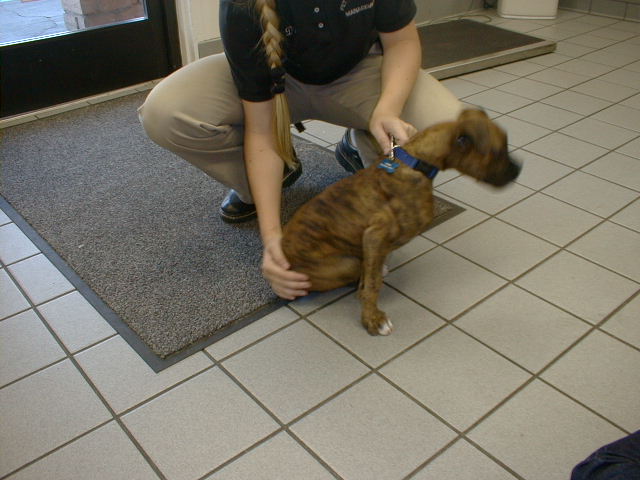The
SIT Instruction ("Place your
rump on the ground.")
We will tell you about
our preferred methods
but we will also tell
you about methods we
prefer NOT to use
because
you may see or
they may be
recommended
to you by someone else. Please
avoid these methods
which use force and
pressure and if our
recommended method does
not work for you send us
an email so we can help
fine tune the process
for you!
These
"NOT our Choice
methods" do not
physically harm
the pet but they
are not the
best training methods
because they are forcing
the pet to do something
it was not willing to do
on their own. It is not
allowing the dog to
figure out what you are
requesting on their own
terms. When the pet is
allowed to figure out
through trial and error
what you want it leads
to higher success with
each additional command
you wish to teach. The
methods which rely on
physical touching also
lead to a pet that
waits for you to touch
them
before they preform the
command which is rarely
convenient for anyone.
Our
Choice: Studies show preferred methods
by certified
and credentialed behavior
professionals and are
the NO FORCE teaching
methods.
1)
Give
a small tasty food treat
for free, to show that you
control treats.
2)
With
your right hand, offer a
food treat, held right at
the nose, but don't
give the treat.
3) Move
your hand with the food
treat up and over the head.
Try to lure the nose up
and back. If he jumps, you
are holding the treat too
far from his nose. If the
dog ignores the treat, wait
until hungry, or choose
a more tasty treat.
4)
If
the dog's head follows
the treat, his spine will
pressure his rump to the
ground naturally.
5) As
the rump touches the ground,
say SIT in a neutral tone,
and praise and give the
treat. Say COME to get the
dog to stand and take a
step, then practice the
SIT. Repeat 10-20 times,
until the dog gets the relationship:
hear the word SIT, assume
the position, get the praise
and treat.
6)
Once
reliable, treat every other
sit, then the BEST sit of
three or five attempts.
Phase out the food over
weeks.
7) The
word SIT, plus the right
hand moving up becomes the
hand signal for the dog
to sit. If the dog's front
feet leave the ground,
you
are holding the food treat too
high.
8) Once
he has it, teach the dog
to "sit for
greetings"
instead of jumping up on
people. The rule is, "I
won't greet you until
you are sitting."
9)
Capture
the
moment every time your
dog sits
and provide a reward.
Rewarding
sitting
and telling her "good
sit" whenever
your dog
sits as a normal
part of her activities
reinforce the behavior.
NOT our
Choice:
Reminder: We tell you
about the
following methods
because
they
are commonly used
and we want you to be
able to discern between
methods.
Place
one hand behind the middle of
the back legs to prevent moving
backward, and "cup"
the back legs forward at the
knee. With the other hand use
the collar push the dog backward
and down. The net effect is
like pushing a person backward,
who is standing in front of
a chair that buckles their legs
causing them to sit. Say SIT
first, the position the dog,
and praise as if it was his
idea, and give a treat. Repeat
exercise about 5 times each
training session, praising the
dog more as you use less pressure
to obtain a sit.
Correct hand position
|
Say
the word, "sit" first.
Then, position
the dog, and praise as if
it was the dog's idea.
Give a treat while the dog
is still sitting.
Then, release by saying,
"okay" and clapping while
moving backwards. |
 NOT
our Choice Method:
NOT
our Choice Method:
Place
one hand on the dog's
back, just in front of the hips.
Spread your index finger and
thumb, and apply inward pressure,
just in front of each hip bone.
The other hand can be on the
collar and gently push back,
into the sit.
NOT our
Choice Method
Use
a head halter. Begin
with your dog at your side or
in front of you. Hold the leash
a few inches
from the leash snap. Pull the
leash forward and upward to point
your dog's nose gently skyward.
As you tip his or her nose up,
the head should go gently back
and the hindquarters will naturally
lower to the ground as the dog
pulls backward against the pressure
at the back of the neck. As soon
as the dog begins to sit, say,
"Sit" and immediately
release the tension on the leash.
Offer a treat as a reward along
with praise. The
dog will quickly associate the
sitting position with the word
"Sit," and will
begin to respond with a lighter
and lighter pull on the leash.
Last Resort
(also NOT our choice)
While
the dog is wearing a neck collar
and leash, pull up on the
collar or leash,
while pressing down on the rump.